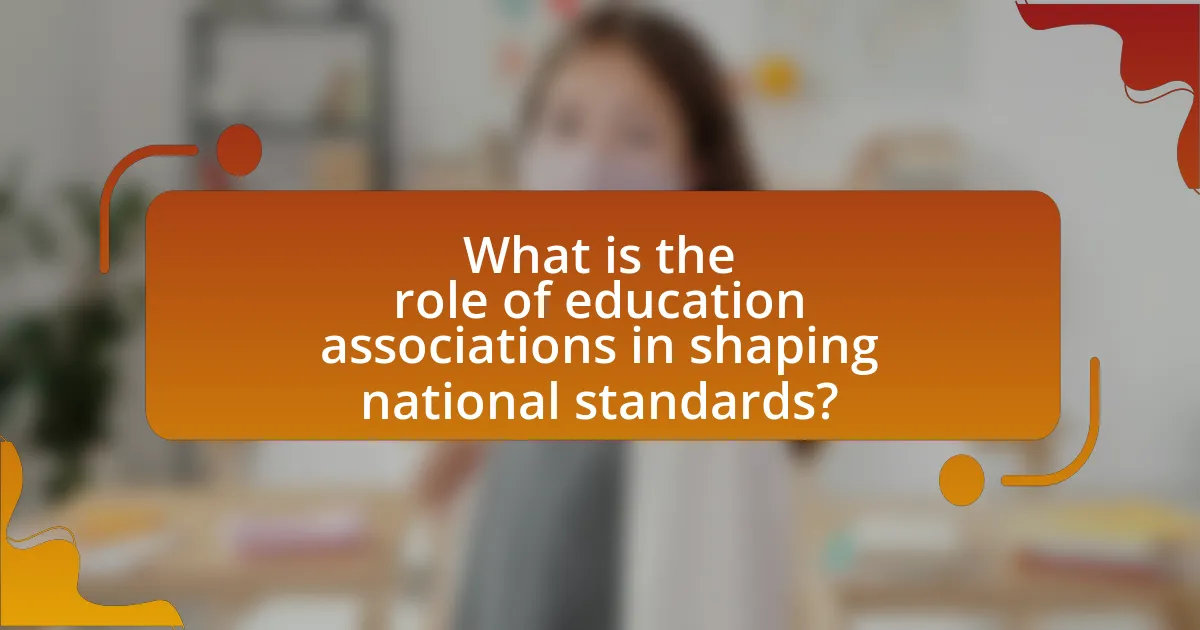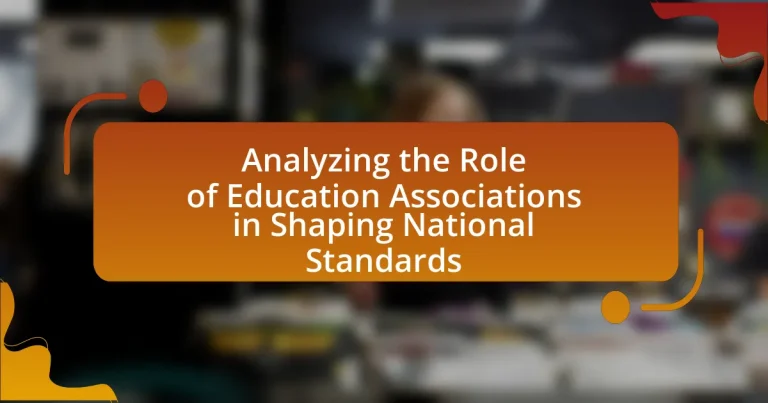Education associations, such as the National Education Association and the American Association of Colleges for Teacher Education, play a vital role in shaping national educational standards through expertise, advocacy, and collaboration. They influence policy development by representing educators’ interests, conducting research, and engaging in lobbying efforts. The article examines the strategies these associations use to advocate for standards, their collaboration with government bodies, and the challenges they face, including diverse stakeholder interests and resource limitations. Additionally, it highlights the importance of member feedback, public perception, and effective collaboration in enhancing their influence on educational quality and policy.

What is the role of education associations in shaping national standards?
Education associations play a crucial role in shaping national standards by providing expertise, advocacy, and a platform for collaboration among educators and policymakers. These associations, such as the National Education Association and the American Association of Colleges for Teacher Education, contribute to the development of standards through research, best practices, and professional development resources. They also influence policy decisions by representing the interests of educators and promoting evidence-based practices, which can lead to the establishment of comprehensive and effective national educational standards. For instance, the Common Core State Standards initiative was significantly influenced by input from various education associations, highlighting their impact on national educational frameworks.
How do education associations influence policy development?
Education associations influence policy development by advocating for specific educational standards and practices that align with their members’ interests. These associations engage in lobbying efforts, provide research and data to policymakers, and facilitate discussions among educators, which helps shape legislative agendas. For instance, the National Education Association (NEA) has historically played a significant role in influencing federal education policy through initiatives like the Every Student Succeeds Act (ESSA), where their input was crucial in defining accountability measures. Additionally, education associations often conduct surveys and publish reports that highlight the needs and perspectives of educators, thereby informing policymakers about the implications of proposed policies.
What specific strategies do education associations use to advocate for standards?
Education associations advocate for standards through strategies such as policy development, collaboration with stakeholders, and professional development initiatives. These associations engage in policy development by creating frameworks and guidelines that align with educational standards, ensuring that their members are informed and equipped to implement these standards effectively. Collaboration with stakeholders, including government agencies, educational institutions, and community organizations, allows education associations to influence policy decisions and promote the adoption of standards at various levels. Additionally, they provide professional development initiatives that offer training and resources to educators, helping them understand and apply the standards in their teaching practices. These strategies are supported by research indicating that effective advocacy leads to improved educational outcomes and greater alignment with national standards.
How do education associations collaborate with government bodies?
Education associations collaborate with government bodies through advocacy, policy development, and resource sharing. These associations represent educators’ interests, providing insights and recommendations that inform government education policies. For example, the National Education Association (NEA) actively engages with federal and state governments to influence legislation, ensuring that educators’ perspectives are considered in decision-making processes. Additionally, education associations often partner with government agencies to develop standards and guidelines, facilitating the implementation of educational reforms. This collaboration is essential for aligning educational practices with national standards, ultimately enhancing the quality of education.
Why are education associations important for national standards?
Education associations are crucial for national standards because they provide a unified voice for educators, facilitating the development and implementation of consistent educational benchmarks. These associations engage in research, advocacy, and collaboration among stakeholders, ensuring that standards reflect current educational needs and practices. For instance, the National Education Association (NEA) plays a significant role in shaping policies that influence curriculum standards across the United States, thereby promoting equity and quality in education. Their involvement helps to align educational practices with national goals, ensuring that all students receive a high-quality education regardless of their location.
What impact do education associations have on educational quality?
Education associations significantly enhance educational quality by establishing standards, providing professional development, and advocating for effective policies. These organizations create frameworks that guide curriculum development and teaching practices, ensuring consistency and high expectations across educational institutions. For instance, the National Education Association (NEA) and the American Federation of Teachers (AFT) have been instrumental in promoting best practices and professional standards that directly influence classroom effectiveness. Research shows that schools affiliated with strong education associations often demonstrate improved student outcomes, as these associations facilitate collaboration among educators and provide access to resources that support teaching excellence.
How do education associations represent diverse educational stakeholders?
Education associations represent diverse educational stakeholders by advocating for their interests, facilitating collaboration, and providing a platform for dialogue. These associations engage various groups, including teachers, administrators, parents, and policymakers, ensuring that multiple perspectives are considered in educational decision-making. For instance, the National Education Association (NEA) actively involves its members in policy discussions, reflecting the views of over 3 million educators. This representation is crucial for shaping national standards that address the needs of all stakeholders, as evidenced by the NEA’s initiatives that incorporate feedback from diverse communities to influence educational reforms.
What challenges do education associations face in shaping national standards?
Education associations face several challenges in shaping national standards, primarily including diverse stakeholder interests, varying state regulations, and resource limitations. Diverse stakeholder interests create conflicts as different groups, such as teachers, administrators, and policymakers, often have differing priorities and perspectives on what standards should entail. Additionally, varying state regulations complicate the process, as education associations must navigate a patchwork of laws and policies that differ significantly across states, making it difficult to establish uniform standards. Resource limitations, including funding and personnel, further hinder the ability of education associations to conduct comprehensive research and advocacy efforts necessary for effective standard development. These challenges collectively impede the ability of education associations to create cohesive and widely accepted national standards.
How do funding and resources affect the effectiveness of education associations?
Funding and resources significantly impact the effectiveness of education associations by determining their capacity to implement programs, conduct research, and advocate for policy changes. Adequate funding allows these associations to hire qualified staff, develop educational materials, and provide professional development opportunities, which enhance their overall influence and reach. For instance, a study by the National Education Association found that associations with higher funding levels were able to engage in more comprehensive advocacy efforts, resulting in improved educational policies at the state and national levels. Additionally, resources enable education associations to collaborate with other stakeholders, thereby amplifying their voice in shaping national standards and practices.
What role does public perception play in the influence of education associations?
Public perception significantly influences the effectiveness and authority of education associations. When the public views these associations positively, they gain credibility, which enhances their ability to advocate for educational policies and standards. For instance, a survey by the National Education Association indicated that 75% of respondents trust teachers’ unions to represent their interests, demonstrating how favorable public perception can empower these organizations to shape national educational standards effectively. Conversely, negative public perception can undermine their influence, as seen in instances where associations faced backlash over controversial policies, leading to diminished support and engagement from stakeholders.
How do education associations adapt to changing educational landscapes?
Education associations adapt to changing educational landscapes by continuously updating their policies, resources, and professional development programs to reflect current educational needs and trends. For instance, they conduct research to identify emerging challenges, such as the integration of technology in classrooms, and subsequently develop guidelines and best practices to support educators. Additionally, education associations often collaborate with stakeholders, including policymakers and educational institutions, to advocate for necessary reforms and ensure that national standards remain relevant and effective. This proactive approach is evidenced by the National Education Association’s initiatives that address issues like equity in education and the incorporation of social-emotional learning into curricula, demonstrating their commitment to evolving alongside the educational environment.
What are the key functions of education associations in standard-setting processes?
Education associations play a crucial role in standard-setting processes by providing expertise, facilitating collaboration, and advocating for best practices. These associations leverage their collective knowledge and experience to develop and refine educational standards that reflect current research and pedagogical advancements. For instance, organizations like the National Education Association (NEA) and the Association for Supervision and Curriculum Development (ASCD) actively engage educators in discussions to ensure that standards are relevant and effective. Their involvement often includes conducting research, hosting conferences, and publishing guidelines that inform policy decisions, thereby ensuring that the standards set are both practical and aligned with educational goals.
How do education associations gather and utilize data for standard development?
Education associations gather and utilize data for standard development through systematic research, surveys, and stakeholder consultations. These organizations often conduct comprehensive surveys to collect quantitative and qualitative data from educators, administrators, and policymakers, which helps identify current educational needs and gaps. For instance, the National Education Association (NEA) regularly surveys its members to gather insights on teaching practices and educational challenges. This data is then analyzed to inform the development of standards that reflect the realities of the classroom and the expectations of the education system. Additionally, education associations may collaborate with research institutions to access existing studies and reports, ensuring that their standards are evidence-based and aligned with best practices in education.
What role do member feedback and engagement play in shaping standards?
Member feedback and engagement are crucial in shaping standards as they provide insights and perspectives that reflect the needs and priorities of the community. This engagement allows education associations to gather diverse viewpoints, ensuring that the standards developed are relevant and effective. For instance, surveys and focus groups conducted by organizations like the National Education Association have shown that member input directly influences policy decisions and standard revisions, leading to more comprehensive and applicable educational frameworks.
What best practices can education associations adopt to enhance their influence?
Education associations can enhance their influence by actively engaging in policy advocacy and building strategic partnerships. By participating in legislative processes and collaborating with stakeholders, such as government agencies and educational institutions, these associations can effectively shape national standards. For instance, the National Education Association (NEA) has successfully influenced educational policy through grassroots lobbying efforts and coalition-building, demonstrating the impact of organized advocacy. Additionally, leveraging data-driven research to support their positions can further solidify their credibility and influence in discussions surrounding educational standards.
How can education associations improve collaboration with other organizations?
Education associations can improve collaboration with other organizations by establishing formal partnerships and engaging in joint initiatives that align with shared goals. For instance, by creating collaborative programs with non-profits, businesses, and governmental agencies, education associations can leverage resources and expertise to enhance educational outcomes. Research indicates that partnerships between educational institutions and community organizations lead to improved student performance and increased access to resources, as seen in the “Partnerships for Student Success” report by the National Education Association. This demonstrates that structured collaboration not only fosters innovation but also strengthens the overall educational ecosystem.
What strategies can education associations implement to increase member involvement?
Education associations can implement strategies such as enhancing communication, providing professional development opportunities, and fostering community engagement to increase member involvement. Enhanced communication through regular newsletters and social media updates keeps members informed and connected, which is crucial for engagement. Professional development opportunities, such as workshops and webinars, cater to members’ needs and interests, encouraging participation. Additionally, fostering community engagement through local events and networking opportunities creates a sense of belonging and encourages members to take an active role in the association. These strategies are supported by research indicating that active communication and professional growth are key factors in member retention and involvement in professional organizations.


